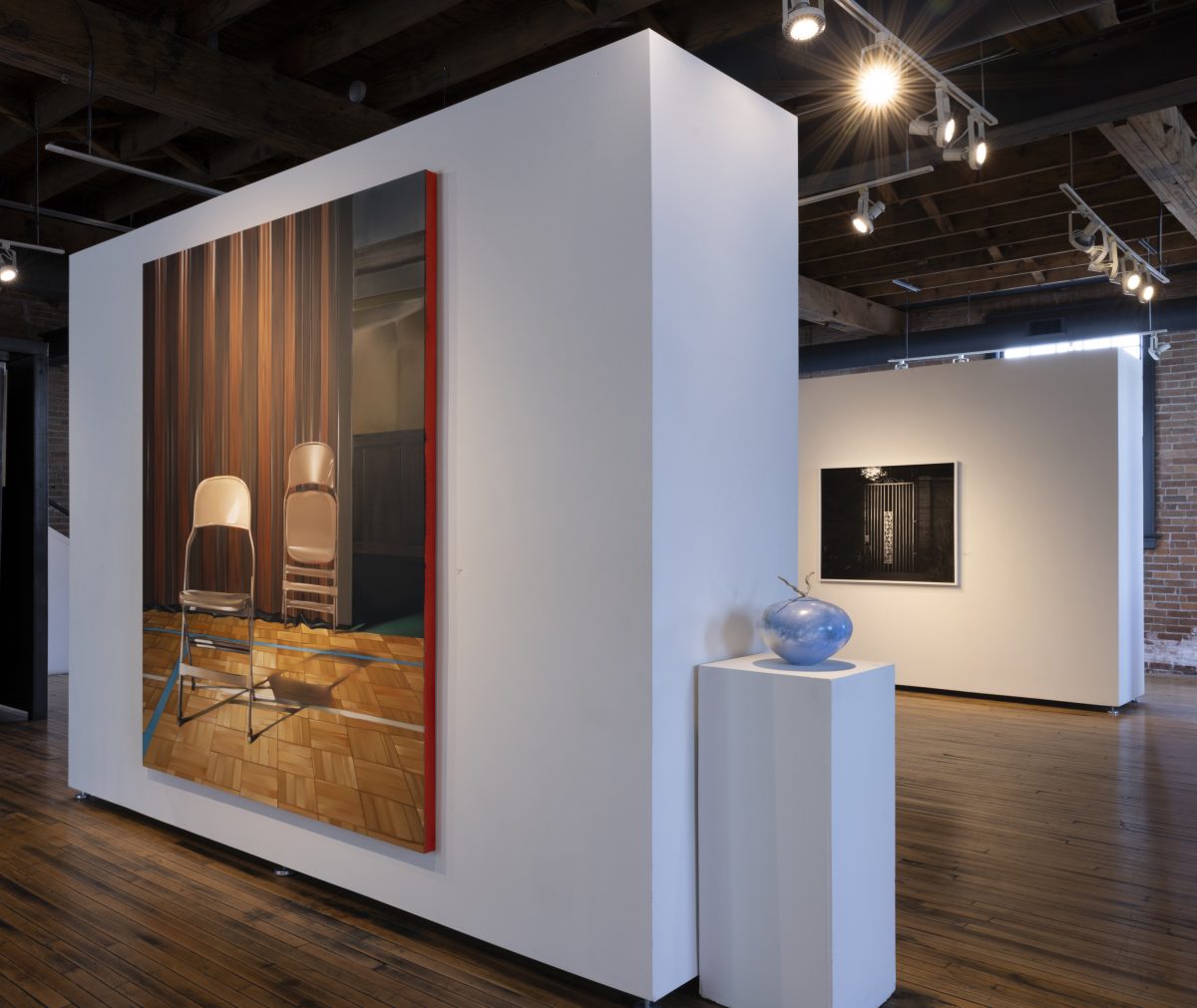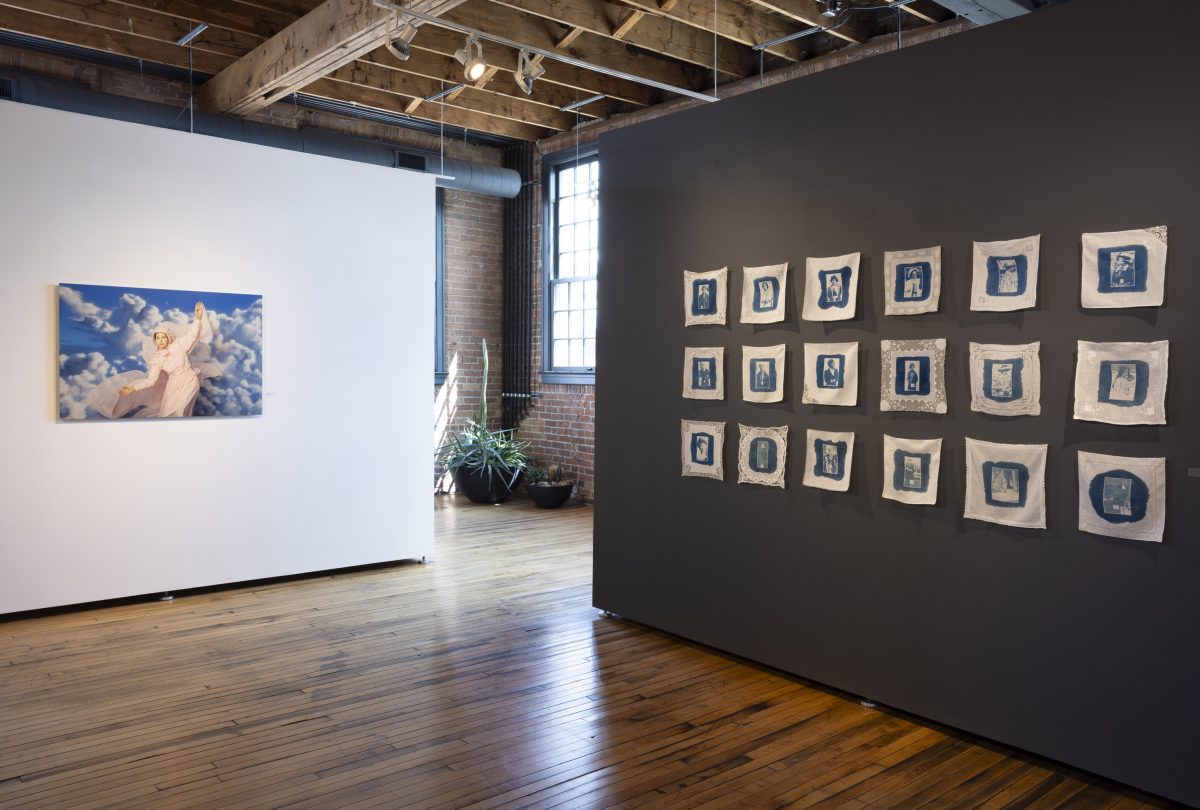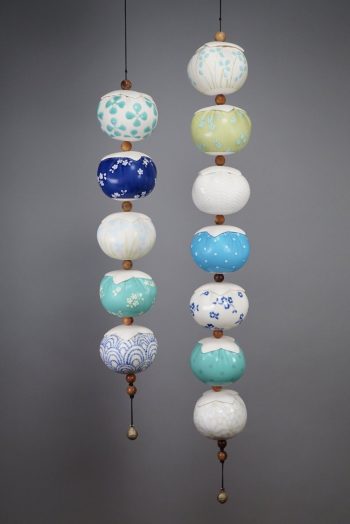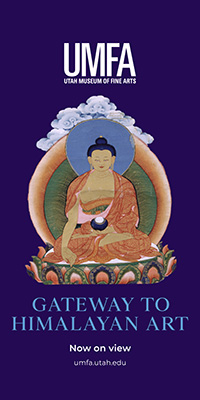
In an installation view of A Woven History at Modern West Fine Art, Rebecca Campbell’s The Wizard (left) plays with scale and concealment to reference LDS cultural spaces and the mythos of The Wizard of Oz, while Suzanne Hill’s blue ceramic pot below it draws visual ties to sky and earth in the surrounding works. In the background, Bailey Rigby’s black-and-white photograph of a metal gate is visible, echoing the visual motifs of closure and concealment. Image courtesy of Modern West Fine Art.
Modern West Fine Art is no stranger to meticulous curation, yet their latest exhibition manages to exceed even already high expectations. A Woven History, where each artwork sits in thoughtful conversation with the others, centers nine female artists, exploring the boundaries of their work in relation to womanhood and the western landscape, calling upon themes of religion, history, the earth and feminism.
As a whole, the exhibit has a wonderfully cohesive feel, even if on a surface level: Emily Hawkins’ monoprint of a young girl’s dress, with its blue and white hues, calls to mind Jorgensen’s cyanotypes at the rear of the exhibit. Angela Ellsworth’s “Pause IX (out of yellow),” shares an almost identical palette with Kiki Gaffney’s “Interior.” And there is something about the grill work in Bailey Rigby’s photograph, “Garden Gate,” that echoes Shalee Cooper’s stark open and closed abstract forms in “Inside Out.” An art exhibit is a visual medium and these congenial reverberations pull a viewer in, and keeps them lingering long enough to discover deeper reverberations.
Angela Ellsworth’s “Stand Back Untitled 2”, first exhibited at Modern West in 2023, makes a favorable return in A Woven History. The self-portrait of the artist in a rose-pink pioneer dress floating against a blue sky explores the constraints of gender and religious ideals of femininity in the Western landscape. The position of Ellsworth’s arm in this self-portrait, with her arms wide open as if she is soaring through the air, becomes more pertinent in this exhibition. Sitting across from this work, the color and decoration Suzanne Hills’ “Forest Lake,” a blue ceramic pot with a reclaimed wood handle, bears a striking resemblance to the blue clouds and background of Ellsworth’s photograph; and the shape of the wood draws an even deeper parallel with its resemblance to Ellsworth’s arm. Though the works differ in medium and form, they stand in conversation with each other. The clay used in “Forest Lake” is sourced from the earth, a direct manifestation of the landscape that mirrors the baby-blue cloud background of “Stand Back Untitled 2”. Viewed together, a deep connection is drawn between earth as a source of both material and meaning and the female experience in the LDS religion.

Angela Ellsworth’s Stand Back Untitled 2 (left) floats with open-armed serenity against a backdrop of clouds, while Amy Jorgensen’s grid of cyanotypes on handkerchiefs (right) confronts the viewer with layered histories of surveillance, intimacy, and femininity. Image courtesy of Modern West Fine Art.
Religious themes are woven throughout the show. Rebecca Campbell’s “The Wizard” is subtle on a grand scale. Playing with proportion, Campbell’s massive 90 by 74 inch canvas zones in on a strikingly limited scene, as if one zoomed in on the corner of an image. The lighting is eerie, the time of day unintelligible, yet even the limited view is unmistakably of the interior of an LDS meetinghouse. The scene appears to be a gymnasium, a foldable wall concealing most of the scene, and an emerald carpeted hallway peeking from the background. The work itself is an homage to The Wizard of Oz, playing off the idea of immense faith in a higher power that turns out to be nothing more than a man behind the curtain. In this case, the foldable wall takes up the majority of the space within the work, its vastness creating this sense of mystery, suspense, and concealment. Two metal chairs, one folded against the wall and one directly confronting the viewer, are the main subject of the work. The single open chair begs the viewer to consider who is in the seat of power, and why it is absent. The Wizard of Oz iconically centers a female protagonist on a journey to find her home, a journey that can be explored further in Campbell’s work.
The powerful connectedness of womanhood is visible throughout the exhibition. Dara Hartman’s “Pierce” is another ceramic work that engages with the exhibition as a whole and calls upon its neighbors. Two sets of eight ceramic pin cushions are strung like pearls from the ceiling, each ornately decorated in floral, chevron, and striped patterns. Like a lineage, each pin cushion passes onto the next, much like the act of sewing, a skill lovingly passed through generations of women. In conversation on the other side of the gallery is Hartman’s “Veil,” a large-scale ceramic work suspended from the ceiling, creating weightlessness in an iconically heavy and fragile medium. From afar, “Veil” appears to be a massive yellow quilt, its different shades casting illusions of movement. Up close, one begins to notice the intricacy and near impossibility of the work, as hundreds of ceramic pieces strung together appear as light as fabric. The artist also created ceramic buttons with magnets to neatly intersect each ceramic piece in a neat vertex. Hartman says that her inspiration for “Veil,“ which was part of her solo exhibit here in March, comes from her grandmother’s quilting. The feminine traditions of sewing, quiltmaking and textile work are not only sacred but eternal. “Veil” and “Pierce” sit in harmony in the exhibition, drawing ties to family, history, and feminine tradition.

Dara Hartman, “Pierce,” 2023, porcelain, paracord, wood beads, metal bell, 43 x 4 x 12 in
Amy Jorgensen’s “Something Old, Something New, Something Borrowed, Something Blue” sits captivatingly on the back wall of the gallery. Eighteen vintage handkerchiefs, arranged in a six-by-three grid, each bear cyanotypes of archival photographs of women. Unbeknownst to the viewer, these portraits are likely the first surveillance images ever taken—they were used to identify and track suffragettes accused of breaking the law. The handkerchiefs serve as powerful vessels, each one lovingly handmade by the artist’s own family. The handkerchief is an intimate and feminine object, often carried close to one’s heart and used to tend to one’s emotions. The piece’s title draws from an old wedding rhyme, a long-held superstition meant to bring luck to brides on their wedding day. Cyanotype, a medium discovered by the 19th-century botanist and photographer Anna Atkins, is another symbolic element of the work. “Something Old, Something New, Something Borrowed, Something Blue” is deeply embedded in the cultural traditions of womanhood, prompting viewers to critically engage with its historical and symbolic significance.
Modern West strikes again with this expertly curated exhibition that embodies the female experience in the landscape of Utah.
A Woven History, Modern West Fine Art, Salt Lake City, through June 27.

Avery Greig always has something to contribute. Whether lost in an art exhibition, meandering in downtown salt lake, or haunting a museum, she always has something to say when it comes to art. With her BA in Art History from the University of Utah, she loves sharing her passions for art and writing wrapped up in one.
Categories: Exhibition Reviews | Visual Arts









